Abstract
Finite element models of a three-dimensional, porous cathode were constructed and analyzed by the COMSOL© multiphysics package (version 3.2). Four types of cathode active material particles, arranged in both regular and random arrays, were modeled. Experimental studies of Li/PEO-LiClO4/Li1+xMn2O4 (where 0 < x < 1) were used to validate simulation results. Two parameters, Li ion diffusivity into Li1+xMn2O4 particles, and contact resistance at the interface between cathode particles and the current collector, were obtained by curve-fitting discharge curves of simulation results of regular array models, with Li1+xMn2O4 particles (3.6?m) with experimental results. Diffusivities of Li-ions found to be 4*10-13, 6*10-13, 1*10-12 and 5*10-12 cm2/s for Li1+xMn2O4 particles sintered at 800, 600, 500 and 450oC, respectively. Contact resistances were found to be 3.5 &Mac189;·cm2 for Li1+xMn2O4 particles prepared at 600 and 800oC, and 10.5 &Mac189;·cm2 for particles prepared at 450 and 500oC. Regular arrays were shown to increase achievable capacity from 5-50% of the theoretical capacity, compared with random arrays, at C/10 for samples sintered at 500oC. Smaller particle sizes of active material particles were also shown to be beneficial for high power density applications, for low diffusivity active materials.
